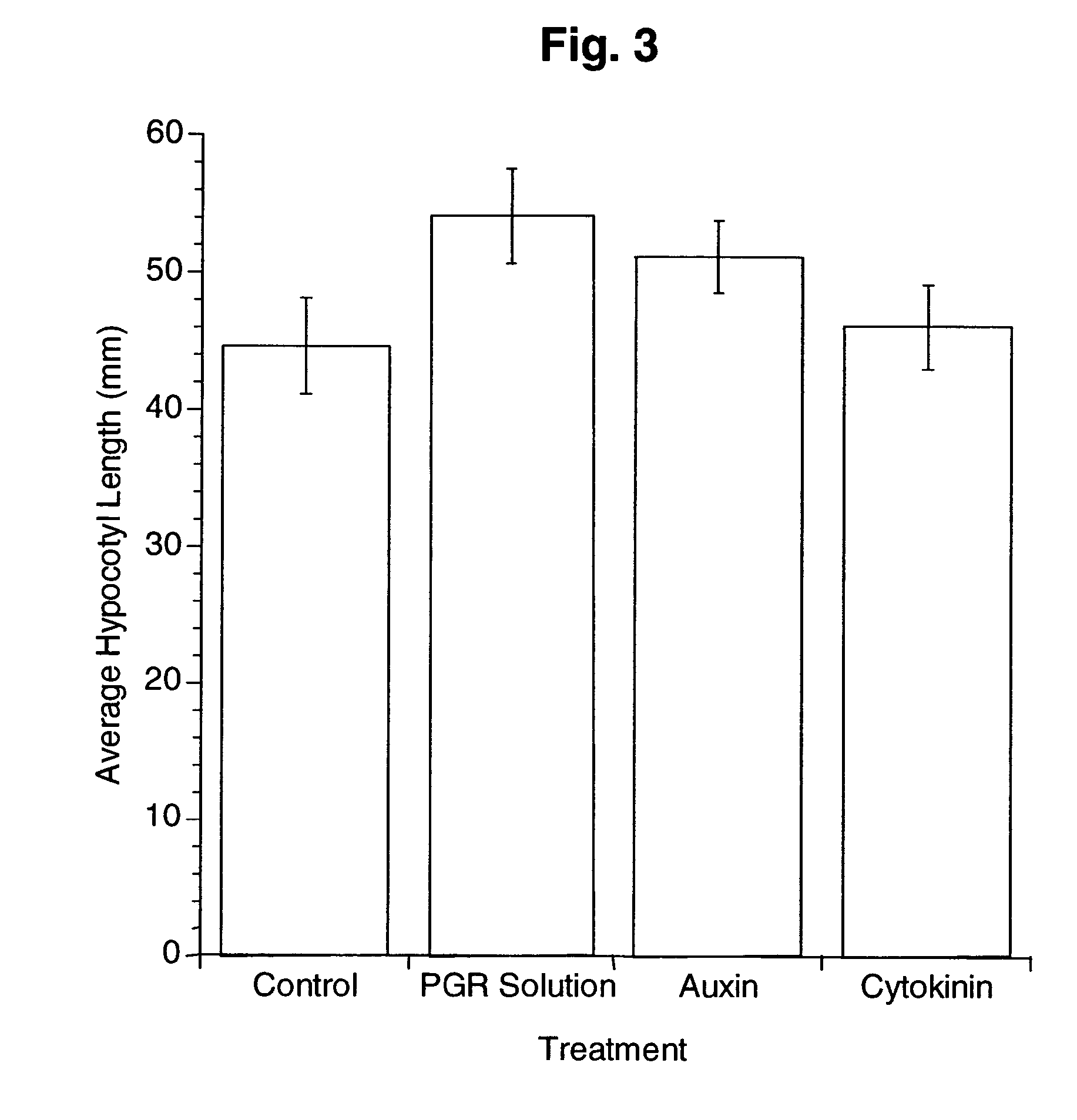Methods for improving growth and crop productivity of plants by adjusting plant hormone levels, ratios and/or co-factors
a technology of plant hormones and ratios, applied in the field of methods for improving the growth and crop productivity of plants by adjusting plant hormone levels and/or ratios, can solve the problems of insufficient application ofauxin to negatively affect the growth of plant tissues, and achieve the effects of reducing the amount of plant hormones, and limiting the excessive growth of vines
- Summary
- Abstract
- Description
- Claims
- Application Information
AI Technical Summary
Benefits of technology
Problems solved by technology
Method used
Image
Examples
example 1
[0104]In this experiment, the effects of PGRs on radish growth were observed. A total of eighty (80) plants were used for this experiment. Twenty (20) plants were treated with water as a control. Twenty (20) plants were treated with a PGR solution corresponding to a rate of 12 oz / acre. The PGR solution is an aqueous solution including 0.015% IAA, 0.005% IBA, 0.009% cytokinin and 0.005% gibberellic acid as active ingredients. Also present as inactive ingredients are 1.000% emulsifier, 0.850% surfactant and 0.050% defoamer. A small measure, 0.0084 ml of this solution, was diluted into 100 ml of water and applied to the soil of a container having a surface area of about 1 square foot to correspond to an application rate of 12 oz / acre. Twenty (20) plants were treated with an auxin solution containing indole-3-acetic acid (IAA) at a rate of 0.84 micrograms in 100 ml water per square foot of surface area of the container. Finally, twenty (20) plants were treated with the cytokinin kinetin...
example 2
[0109]In this experiment, the effects of PGRs on tomato yield were determined. Tomato variety TSH04, which is a processing tomato, was used. All plants were grown in five gallon pots in a greenhouse. Eight plants were used for each treatment. Application of the treatments was done aerially to eight plants and in the soil for eight plants to allow comparison of soil versus foliar application of the PGRs. Treatments were 6 oz / acre PGR solution. The treating solutions were prepared by diluting 0.0042 ml of concentrated solution into 100 ml water for application to the soil, or into 50 ml water for foliar application. The IAA solution was prepared by diluting 0.42 micrograms of IAA into 100 ml water for application to the soil, or into 50 ml water for foliar application. The cytokinin solution was prepared by diluting 0.42 micrograms of kinetin into 100 ml water for application to the soil, or into 50 ml water for spraying of the foliage. The solution containing both IAA and kinetin at ...
example 3
[0112]In this experiment, the effect of PGRs on cucumber internode length was determined. The cucumber variety used was the National pickling cucumber distributed by NK Lawn & Garden Co. (Chattanooga, Tenn.). Eight plants were used per treatment. Treatments were applied to the soil of each five-gallon pot containing one plant per pot. Treatments were 6 oz / acre PGR solution. The final PGR solution was prepared by diluting 0.0042 ml of the concentrated solution into 100 ml water. The IAA solution was prepared by diluting 0.42 micrograms of IAA into 100 ml water. The cytokinin solution was prepared by diluting 0.42 micrograms of kinetin into 100 ml water. Finally, plants were treated with 6 oz / acre N-Large. The treating solution was prepared by diluting 0.0042 ml of the commercial solution into 100 ml water. N-Large is a formulation containing 4 percent gibberellin (GA3). Water was used as a control. Treatments were applied to the soil at the time of planting, and weekly thereafter. Tw...
PUM
 Login to View More
Login to View More Abstract
Description
Claims
Application Information
 Login to View More
Login to View More - R&D
- Intellectual Property
- Life Sciences
- Materials
- Tech Scout
- Unparalleled Data Quality
- Higher Quality Content
- 60% Fewer Hallucinations
Browse by: Latest US Patents, China's latest patents, Technical Efficacy Thesaurus, Application Domain, Technology Topic, Popular Technical Reports.
© 2025 PatSnap. All rights reserved.Legal|Privacy policy|Modern Slavery Act Transparency Statement|Sitemap|About US| Contact US: help@patsnap.com



